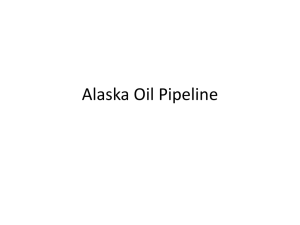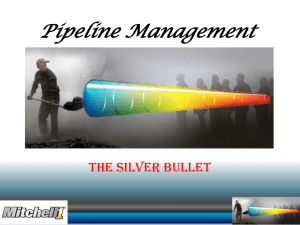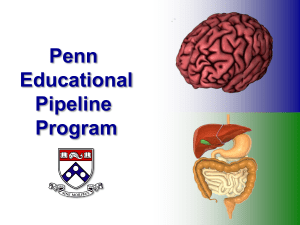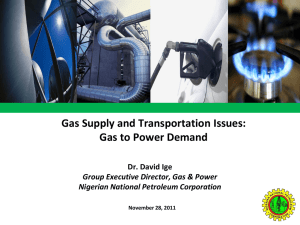Randall Allen, Associate Staff Consultant, UTSI International
advertisement
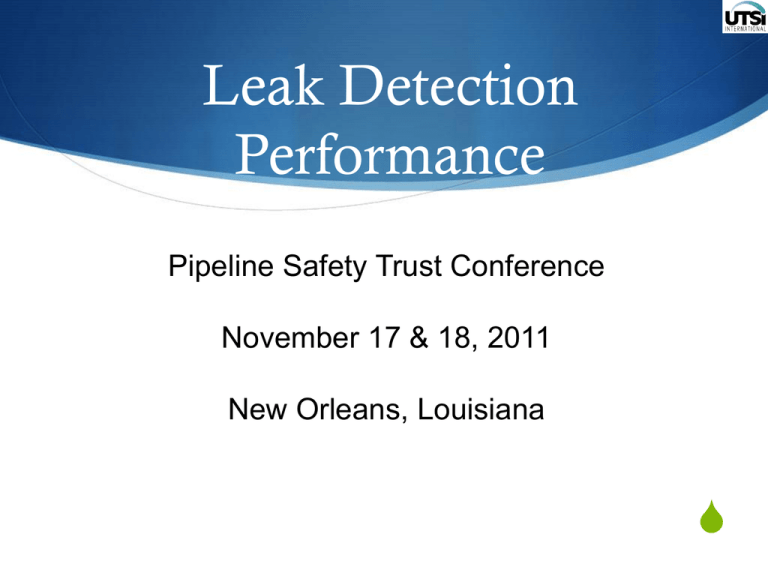
Leak Detection Performance Pipeline Safety Trust Conference November 17 & 18, 2011 New Orleans, Louisiana S Why Leak Detection? S Why Leak Detection? (Contd) S Minimize the volume of lost fluid S Reduce risk of fire, explosion or other safety hazards S Protect the company S Minimize cleanup costs with an early response to a leak warning S Protect reputation S Demonstrable acceptance of responsibility by executing a proactive leak detection program S Always increasing regulatory interest in pipeline integrity programs; including leak detection November 17 & 18, 2011 3 Pipeline Safety Trust 2011 Pipeline Safety Conference History S Manual pressure/flow readings and evaluation S Voice communication between the field and any center of responsibility that may exist, or with other stations along the line S Familiarity with the pipeline behavior by controllers and technicians was critical S Right-of-way observation including walk-overs and fly-overs were among few leak detection options November 17 & 18, 2011 4 Pipeline Safety Trust 2011 Pipeline Safety Conference Automated Measurements S Proprietary logging systems and SCADA S Transmitter and meter technology S Automation tools and products that acquire accurate information about hydraulic behavior S Tools to assist in evaluating the relationships among measurements November 17 & 18, 2011 5 Pipeline Safety Trust 2011 Pipeline Safety Conference Leak Detection Performance S From the former API 1155 (Evaluation Methodology for Software Based Leak Detection Systems): S The system correctly indicates that there is no leak S The system correctly indicates that there is a leak S The system incorrectly indicates that there is a leak (false alarm) S The system incorrectly indicates that there is no leak (failure to detect) S Definitions absorbed into API RP-1130 (Computational Pipeline Monitoring for Liquid Pipelines) November 17 & 18, 2011 6 Pipeline Safety Trust 2011 Pipeline Safety Conference Performance Metrics S Sensitivity – Combination of the size of a detectable leak and the time required to detect it S Reliability – A measure of the system’s ability to accurately assess whether a leak exists or not S Accuracy – The ability of a system to estimate leak parameters such as leak flow rate, total volume lost, and leak location S Robustness – The ability of a system to continue to function during unusual hydraulic conditions or when data is compromised November 17 & 18, 2011 7 Pipeline Safety Trust 2011 Pipeline Safety Conference Meter-Based Leak Detection S Most widely used method on long haul pipelines S Requires meters at all entry and exit points S Achievable sensitivity limited by meter accuracy S Some methods can be implemented in SCADA; or are options with SCADA products S Some products are stand-alone and driven by SCADA data S Alarm thresholds must tolerate and expect the imbalance in meter readings as the line packs and unpacks S Leak evaluation algorithms that correlate actual changes in linepack with meter imbalance provide the best performance November 17 & 18, 2011 8 Pipeline Safety Trust 2011 Pipeline Safety Conference API 1149 Performance Predictions S Predicts the theoretical best performance possible with configured uncertainties S No margin for false alarm prevention S Temperature uncertainty and related changes in density during transit is largest influence on performance S Not uncertainty in measurement, but uncertainty in temperature profile along the line S One type of leak detection system can more accurately estimate the temperature profile than other systems November 17 & 18, 2011 9 Pipeline Safety Trust 2011 Pipeline Safety Conference Definitions S Dry Volume – Volume of the pipeline at atmospheric pressure and a reference temperature S Linepack – The incremental quantity of fluid in the line in addition to the dry volume influenced by pressure and fluid temperature S Linepack is heavily influenced by temperature’s effect on fluid density as is pressure, but often to a lesser degree S Profile – Value of a parameter over the length of the pipeline segment November 17 & 18, 2011 10 Pipeline Safety Trust 2011 Pipeline Safety Conference Definitions (cont) S Uncertainty – Potential error in measurements that must be expected and accounted for; also the degree to which something is unknown and must be estimated or assumed based on somewhat related measurements. S Real-Time Transient Model (RTTM) – Accurately tracks fluid temperature/density profiles with consideration of pressure in order to reduce uncertainty in the linepack November 17 & 18, 2011 11 Pipeline Safety Trust 2011 Pipeline Safety Conference Meter Quality vs. Performance Influence of Meter Quality on Performance 4.5 4.16 4.2 4.1 4.1 % Nominal Flow (74 kbph) 4 3.5 3 .1, .1 % Meters .25, .25 % Meters 2.5 .5, .5% Meters 2.26 2.1 2.1 2.0 2 .1, .25 Meters .1, .5 % Meters 1.68 1.5 1.4 1.43 1.4 1.29 1.2 1.141.08 1.1 1.1 1.1 1.0 1.061.04 1.0 0.9 0.9 0.8 0.9 0.8 0.8 0.8 0.7 0.6 0.7 0.6 0.6 0.5 0.6 0.6 0.5 0.5 0.4 0.4 0.4 0.4 0.4 0.3 1.5 1 0.5 .1, 1% Meters 1.03 1.02 1.01 1.01 1.01 0.7 0.5 0.4 0.3 0.3 0.7 0.5 0.4 0.3 0.2 0.7 0.5 0.4 0.3 0.2 0.7 0.5 0.4 0.3 0.2 0.7 0.5 0.4 0.3 0.1 0 0 10 20 30 40 50 60 70 80 90 Detection Time November 17 & 18, 2011 12 Pipeline Safety Trust 2011 Pipeline Safety Conference Meter-Based Leak Basics S Flow/Pressure/Temperature measurements only at segment end-points S Metered flow accuracy important for high sensitivity S Fluid density (molecules/mass per unit volume) varies significantly with temperature S Warm fluid is less dense; Cold fluid is more dense S Temperature/density profile uncertainty is the most limiting factor in leak detection for some pipelines November 17 & 18, 2011 13 Pipeline Safety Trust 2011 Pipeline Safety Conference Volumetric Flow Measurement S Benefits of volumetric (not corrected for temperature and pressure) flow measurement S Barrel-to-barrel assessment tolerates differences in density at injection and delivery points S Tolerates switching injection sources of different temperatures S Useful on short lines with small changes in temperature/density during transmission S Not useful where temperature/density profiles are significant due to heat loss November 17 & 18, 2011 14 Pipeline Safety Trust 2011 Pipeline Safety Conference Net barrel Flow Measurement S Benefits of net (corrected for temperature and pressure) flow measurement S Useful for custody transfer S Under steady-state conditions, fluid injected at lower density will balance with delivered fluid at higher density S Injections at slightly higher volumetric flow balances with deliveries at lower volumetric flow S Assumes a stable temperature/density profile November 17 & 18, 2011 15 Pipeline Safety Trust 2011 Pipeline Safety Conference Net Flow Measurement Issues S Transient conditions thwart many algorithms involving net flow measurements S Line packing and unpacking still result in an apparent net flow imbalance as with basic volume balance methods S Net barrel flow measurements aggravate simple balance algorithms where a difference in density exists at injection and delivery points except under steady-state stable conditions November 17 & 18, 2011 16 Pipeline Safety Trust 2011 Pipeline Safety Conference Natural Flow Imbalance S Difference in injected fluid density and delivered fluid density S Gradual change in fluid density during transit S Temperature/density profiles are poorly understood by most simple algorithms S Profile changes shape with changes in flow rate S Water crossings and occasionally wet soil increase thermal conductivity November 17 & 18, 2011 17 Pipeline Safety Trust 2011 Pipeline Safety Conference Meter-Based Leak Detection Limitations S Accounting for changes or disturbances in linepack S Operational changes causes the line to pack or unpack as a normal occurrence S Short-term hydraulic disturbances (transients), including changes in injection temperatures, and their effect on linepack must be tolerated or understood in short-term evaluation algorithms used in rapid assessments S Over extended periods any effects of transients are diluted; thus allowing good sensitivity by most meter-based solutions over long observation intervals November 17 & 18, 2011 18 Pipeline Safety Trust 2011 Pipeline Safety Conference Key Concepts S Pressures and temperatures under steady-state conditions provide current linepack characteristics S Divergence of meter readings (greater imbalance) should be reflected in linepack changes as seen in pressures S Transients disturb this information and can lead to significant shortterm linepack uncertainty S Over long time intervals any observed variations in linepack become insignificant compared to the quantity of fluid passing through the pipeline system S Long-term sensitivity settings do not require as much tolerance of linepack uncertainty as do short term leak detection thresholds November 17 & 18, 2011 19 Pipeline Safety Trust 2011 Pipeline Safety Conference Linepack Estimation S Fluid density assumed to be an average of injection and delivery density S Weighted average S Custom algorithms for curve fitting S RTTM thermal models track fluid density along the line S Change in flow rate alters the temperature/density profile as a new quiescent state develops November 17 & 18, 2011 20 Pipeline Safety Trust 2011 Pipeline Safety Conference Profiles S Temperature S Occurs when injection and delivery temperatures differ S Subject to heat transfer characteristics of environment S Varies with flow rate / transit time S Pressure S Varies as batched fluids of different characteristics travel S Varies as batches of different densities travel over mountains S Profiles are accurately tracked by Real-Time Transient Models November 17 & 18, 2011 21 Pipeline Safety Trust 2011 Pipeline Safety Conference Real-Time Transient Model S Most sophisticated volume/mass balance tool S Includes a thermal model to increase the accuracy of linepack S S S S evaluation, thus allowing a shorter detection time for a detectible leak Tracks heat transfer along the line and develops accurate temperature/density profiles as step changes in flow rates or injection temperatures occur Allows thermal model tuning to achieve the best performance by modeling the hydraulic behavior accurately Automatic tuning capabilities Instrument sanity checking November 17 & 18, 2011 22 Pipeline Safety Trust 2011 Pipeline Safety Conference RTTM Myths S Software is expensive S Not significantly more expensive S Software requires special skills S Training and full technical support is offered by vendors S Knowledge of the pipeline physical details is needed S Software requires ongoing maintenance S Not needed, once performance is satisfactory, but further tuning is often performed to continually improve performance S Required if the pipeline network is changed November 17 & 18, 2011 23 Pipeline Safety Trust 2011 Pipeline Safety Conference Static Pressure Testing S Extremely high sensitivity S Zero (0) flow results in zero (0) uncertainty in flow measurement S Works well in a relatively incompressible liquid environment S Requires pressure control equipment November 17 & 18, 2011 24 Pipeline Safety Trust 2011 Pipeline Safety Conference Static Pressure Testing (contd) S Shut in under pressure at near operating pressure S Monitor pressure decay for a period of time S Drop pressure by half S Monitor pressure decay for a period of time S A consistent pressure decay rate indicates decreasing density due to heat transfer S A different pressure decay rate indicates a leak whose rate is pressure dependent November 17 & 18, 2011 25 Pipeline Safety Trust 2011 Pipeline Safety Conference Static Pressure Test Trends November 17 & 18, 2011 26 Pipeline Safety Trust 2011 Pipeline Safety Conference Conclusion S Simple linepack assessment algorithms have a place where linepack is stable and linepack variations and uncertainty do not adversely affect leak assessment S RTTM technology significantly reduces linepack uncertainty in transient environments and enables leak detection approaching the limits imposed by meter accuracy S Static pressure testing is a useful integrity verification tool S Matching the proper tool to the pipeline’s operation is critical November 17 & 18, 2011 27 Pipeline Safety Trust 2011 Pipeline Safety Conference Training & Response S A critical component of any pipeline integrity management program S Response protocol should be included in training and be enforced S Controller can shut down the line on any suspicion of a leak S Details regarding actions, reporting, etc. S No internal penalty for reasonable judgment S A culture focused on pipeline integrity management is critical November 17 & 18, 2011 28 Pipeline Safety Trust 2011 Pipeline Safety Conference References S API 1130 – Computational Pipeline Monitoring for Liquid Pipelines S API 1149 – Pipeline Variable Uncertainties and Their Effects on Leak Detectability S API 1161 – Guidance Document for the Qualification of Pipeline Personnel S 49 CFR Part 192 - TRANSPORTATION OF NATURAL AND OTHER GAS BY PIPELINE: MINIMUM FEDERAL SAFETY STANDARDS S 49 CFR Part 195 - TRANSPORTATION OF HAZARDOUS LIQUIDS BY PIPELINE November 17 & 18, 2011 29 Pipeline Safety Trust 2011 Pipeline Safety Conference Contact UTSI UTSI - U.S. Headquarters 1560 West Bay Area Boulevard Suite 300 Friendswood, Texas USA 77546 Telephone: +1 281 480 8786 Fax: +1 281 480 8008 Email: info@utsi.com WWW: http://www.utsi.com Daniel W. Nagala (dnagala@utsi.com) President & CEO November 17 & 18, 2011 UTSI - Europe Raimundo Fernandez Villaverde 43, 6L 28003 Madrid, Spain Telephone: Fax: Email: WWW: +34 (91) 534 07 49 +34 (91) 535 42 57 info@utsi.com http://www.utsi.com Catalina Frey (cfrey@utsi.com) Senior Consultant Daniel W. Nagala (dnagala@utsi.com) President & CEO 30 Pipeline Safety Trust 2011 Pipeline Safety Conference

